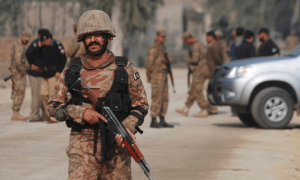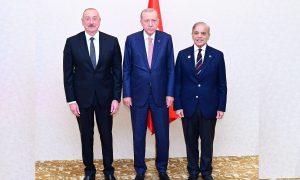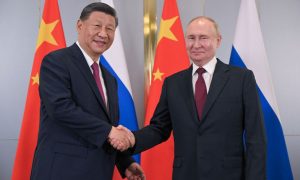Pakistanis have a consensus that nuclear weapons capability provides the country with an unbreakable defensive fence against its arch-rival India. The Indian ruling elite, cherishing Akhand Bharat (Greater India) and pursuing aspirations to establish hegemony in South Asia, has been increasing the defense budget, investing immensely in developing modern weaponry and purchasing military hardware from foreign contractors. Despite these determinations, the Modi government has refrained from military aggression against Pakistan due to the risk of the conflict escalation having a nuclear dimension.
Pakistan conducted six nuclear tests in May 1998 to deter India’s nuclear blackmail and aggression. Since then, the people of Pakistan have observed Youm-i-Takbeer (The Day of Greatness) every May 28 to commemorate the nuclear tests conducted at the hills of Chagai, Balochistan. The nation celebrated the 26th anniversary of the Youm-e-Takbeer with great zeal.
Prime Minister Shehbaz Sharif tweeted, “May 28 signifies more than just a mere commemoration of a day; it encapsulates the narrative of our nation’s arduous yet remarkable path towards establishing a credible minimum deterrence.” Acting President Syed Yousuf Raza Gillani said, “Indeed, it was the collective determination of our civil and military leadership as well as our scientific acumen and unwavering dedication to national defense that propelled us forward.”
Pakistan’s nuclear decision-making is very much determined by its regional strategic environment. Therefore, both national and international nuclear pessimists’ maligning and horrifying propaganda against Pakistan’s nuclear program, as well as the United States and its like-minded Western nation’s economic sanctions, have failed to thwart Pakistan’s nuclear weapon program’s evolution since the last quarter of the twentieth century.
Pakistan’s nuclear weapons capability has prevented the escalation of various conflicts between India and Pakistan during the last 26 years. This testifies that on May 28, 1998, then Prime Minister Nawaz Sharif made a rational decision to conduct the five nuclear explosions to restore the strategic equilibrium in the region that was unbalanced due to India’s five nuclear weapons tests on May 11 and 13, 1998. Precisely, being a rational actor in the community of sovereign nations, Pakistan has concluded that without its indigenous nuclear weapon competence, it would not be able to check India’s military blackmail.
Islamabad has systematically modernized nuclear weapons and formulated a nuclear posture. On September 5, 2013, Pakistan’s National Command Authority announced that the country acquired ‘Credible Minimum Full Spectrum Nuclear Deterrence’ ability and capability.
Credible minimum deterrence is a dynamic concept related to the strategic environment, technological imperatives, and national security needs. Indeed, the shift in Pakistan’s nuclear posture resulted from rational decision-making processes and qualitative and quantitative improvement in its nuclear arsenal.
The dynamics of contemporary global politics and the degraded South Asian strategic environment impose upon Pakistan an imperative to address its defensive capability shortfalls and bolster its deterrence and defense posture to check the Indian ruling elite’s aggressive design and recent irresponsible statements against Pakistan’s nuclear capability.
Against the backdrop of the extensive buildup of Indian missiles and purchases of S-400 surface-to-air missile defense from Russia, Pakistani strategic pundits are engaged in assessing its full spectrum deterrence posture credibility and how best to address the relative capability gap with India.
Currently, acquiring greater numbers of (and more capable) cruise and ballistic missiles and perfecting MIRVE capability have become an increasing necessity of Islamabad. Notably, the contemporary international strategic environment is conducive to missile development.
The termination of the 1987 Intermediate-Range Nuclear Forces (INF) Treaty in 2019 and the 1972 ABM Treaty in 2002 compels the militarily insecure nations to modernize their cruise and ballistic missiles and uninhabited aerial vehicles (UAVs) and invest in the research and development of missile defense systems.
Besides, the strategic competition between China, Russia, and the United States, and five nuclear flashpoints, i.e., Ukraine, the Gaza war, the Taiwan Strait, the Korean peninsula, and South Asia, are fuelling demand for new offensive and defensive missile capabilities.
Pakistani policymakers seem disinclined to develop missile defense systems because of the perception of their operability efficacy in India and Pakistan’s military theater and financial cost. Therefore, despite India’s development of missile defense systems, Islamabad is only focusing on its offensive missile inventories.
Admittedly, the strategic stability in South Asia demands the rational conduct of the Indian and Pakistani ruling elites in the domain of missile development. They have to revive the confidence-building measures to avoid the repercussions of the accidental or inadvertent fire of a missile, ideally intended for missile arms control in South Asia.
To conclude, modernizing Pakistan’s defense and deterrence requirements is of paramount importance to demonstrate to India that it can gain no advantages by undertaking a niche arms race focused on Pakistan’s economic shortfalls. Thus, the modernization of Pakistan’s missiles and nuclear forces and the upgrading of its precision-strike capabilities are necessary for its full-spectrum deterrence posture.























